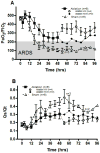Effect of ablated bronchial blood flow on survival rate and pulmonary function after burn and smoke inhalation in sheep
- PMID: 19303716
- PMCID: PMC2739875
- DOI: 10.1016/j.burns.2008.12.013
Effect of ablated bronchial blood flow on survival rate and pulmonary function after burn and smoke inhalation in sheep
Abstract
The bronchial circulation plays a significant role in the pathophysiological changes of burn and smoke-inhalation injury. Bronchial blood flow markedly increases immediately after inhalational injury. This study examines whether the ablation of the bronchial artery attenuates pathophysiological changes and improves survival after burn and smoke-inhalational injury in an ovine model. Acute lung injury was induced by 40% total body surface-area third-degree cutaneous burn and cotton smoke inhalation (48 breaths of cotton smoke, <40 degrees C) under deep anaesthesia. Twelve adult female sheep were divided into two groups: (1) sham (injured, non-ablated bronchial artery, n=6); (2) ablation (injured, ablated bronchial artery, n=6). Ablation of the bronchial artery was performed 72 h before the injury. The experiment was continued for 96 h. Burn and smoke-inhalation injury significantly increased regional blood flow in the bronchi. Ablation of the bronchial artery significantly reduced acute regional blood flow increases in the proximal and distal bronchi. All animals in the ablation group survived to 96 h. Four of these were successfully weaned off the ventilator. Three animals of the sham group met standardised euthanasia criteria at 60 h, while another met the criteria at 78 h. The lung wet-to-dry weight ratio, histology score and myeloperoxidase (MPO) activity were significantly increased by the insult, but ablation of the bronchial artery attenuated these changes. Burn and smoke-inhalation injury induced a significant increase in bronchial blood flow and accelerated airway obstruction, pulmonary vascular changes, pulmonary oedema and pulmonary dysfunction. Ablated bronchial circulation attenuated these pathophysiological changes.
Figures







References
-
- Saffle JR, Davis B, Williams P. Recent outcomes in the treatment of burn injury in the United States: a report from the American Burn Association Patient Registry. J Burn Care Rehabil. 1995;16(3 Pt 1):219–32. discussion 288–9. - PubMed
-
- Barrow RE, Spies M, Barrow LN, Herndon DN. Influence of demographics and inhalation injury on burn mortality in children. Burns. 2004;30(1):72–7. - PubMed
-
- Stothert JC, Jr, Ashley KD, Kramer GC, et al. Intrapulmonary distribution of bronchial blood flow after moderate smoke inhalation. J Appl Physiol. 1990;69(5):1734–9. - PubMed
-
- Linares HA. A report of 115 consecutive autopsies in burned children: 1966–80. Burns Incl Therm Inj. 1982;8(4):263–70. - PubMed
-
- Linares HA, Herndon DN, Traber DL. Sequence of morphologic events in experimental smoke inhalation. J Burn Care Rehabil. 1989;10(1):27–37. - PubMed
Publication types
MeSH terms
Substances
Grants and funding
LinkOut - more resources
Full Text Sources
Medical
Research Materials
Miscellaneous

